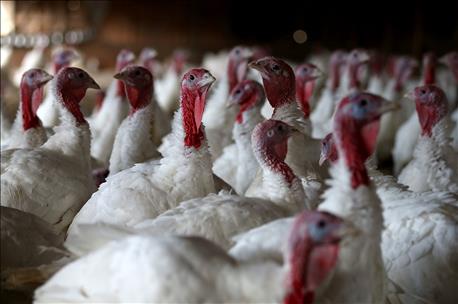
With harvest wrapped up in most parts of Nebraska, and with Thanksgiving this week, I want to take a moment to list a few reasons to thank a farmer this Thanksgiving – a holiday many trace back to the 1621 harvest celebration after a successful growing season at Plymouth.

REASONS TO BE THANKFUL: Nebraska's 17 turkey growers, members of the Nebraska Turkey Growers Cooperative, raise around four million turkeys each year. The economic impacts of commercial turkey production and processing in Nebraska are calculated to be over $110 million. Copyright Justin Sullivan, Getty Images
1. I'll start with the obvious – turkey. The National Turkey Federation (NTF) estimates approximately 45 million turkeys are eaten on Thanksgiving. The only turkey processing plant in Nebraska, Nebraska Turkey Growers Cooperative in Gibbon, produces over 55 million pounds of turkey per year, according to the Nebraska Department of Agriculture. Nebraska's 17 turkey growers, members of the Nebraska Turkey Growers Cooperative, raise around four million turkeys each year. The economic impacts of commercial turkey production and processing in Nebraska are calculated to be over $110 million.
Turkey may be the first thing that comes to mind, but whatever it is you fill your plate with at the dinner table on Thanksgiving among the smorgasbord of turkey, roast beef, ham, cranberry sauce, mashed potatoes and gravy, sweet potato casserole, or pumpkin pie, you can bet it got its start on a farm. Today, each American farmer feeds 155 people on average. Meanwhile, less than 2% of the U.S. population, and less than 5% of the Nebraska population, farms, according to the USDA Census of Agriculture statistics.
2. Here's one that's a little less obvious – football. On Thanksgiving, families across the U.S. tune in to college or professional football games – a tradition that some say goes back as far as the late 1800s. What does this have to do with agriculture? While originally made from inflated pig bladders (hence the name "pigskin"), modern footballs are now made from cowhide and vulcanized rubber. According to Wilson Sporting Goods, the supplier of the official NFL footballs, that cowhide is sourced from feedlots in Iowa, Kansas, and Nebraska – which happens to be the leading state for cattle on feed.
3. According to USDA Economic Research Service Statistics, on average, Americans spend less than 10% of their total income on food. That's the lowest percentage of any country. That means American consumers can spend more of their disposable income on other goods and services – including that day after Thanksgiving that's become known as "Black Friday" when many consumers flock to nearby retailers to kick off their holiday shopping.
4. For most farmers, the work doesn't stop during the holiday season. I know from personal experience – as does anyone who comes from a beef cattle background – that daily chores don't take a holiday. Whether it's caring for cattle, planning for the upcoming season, repairing and maintaining equipment, or attending winter meetings, there are always things to be done.
5. The last reason is a little more personal for me. Agriculture is, after all, one of the key reasons I became a journalist, and I'm sure many ag journalists would agree – if it weren't for farmers, we wouldn't be able to do what we do.
Even as we're chowing down on Thanksgiving, it can be easy for those not directly involved in agriculture to forget where that food came from. So this Thanksgiving, take time to relax, spend time with family, eat plenty of animal protein, and thank a farmer.
About the Author(s)
You May Also Like






